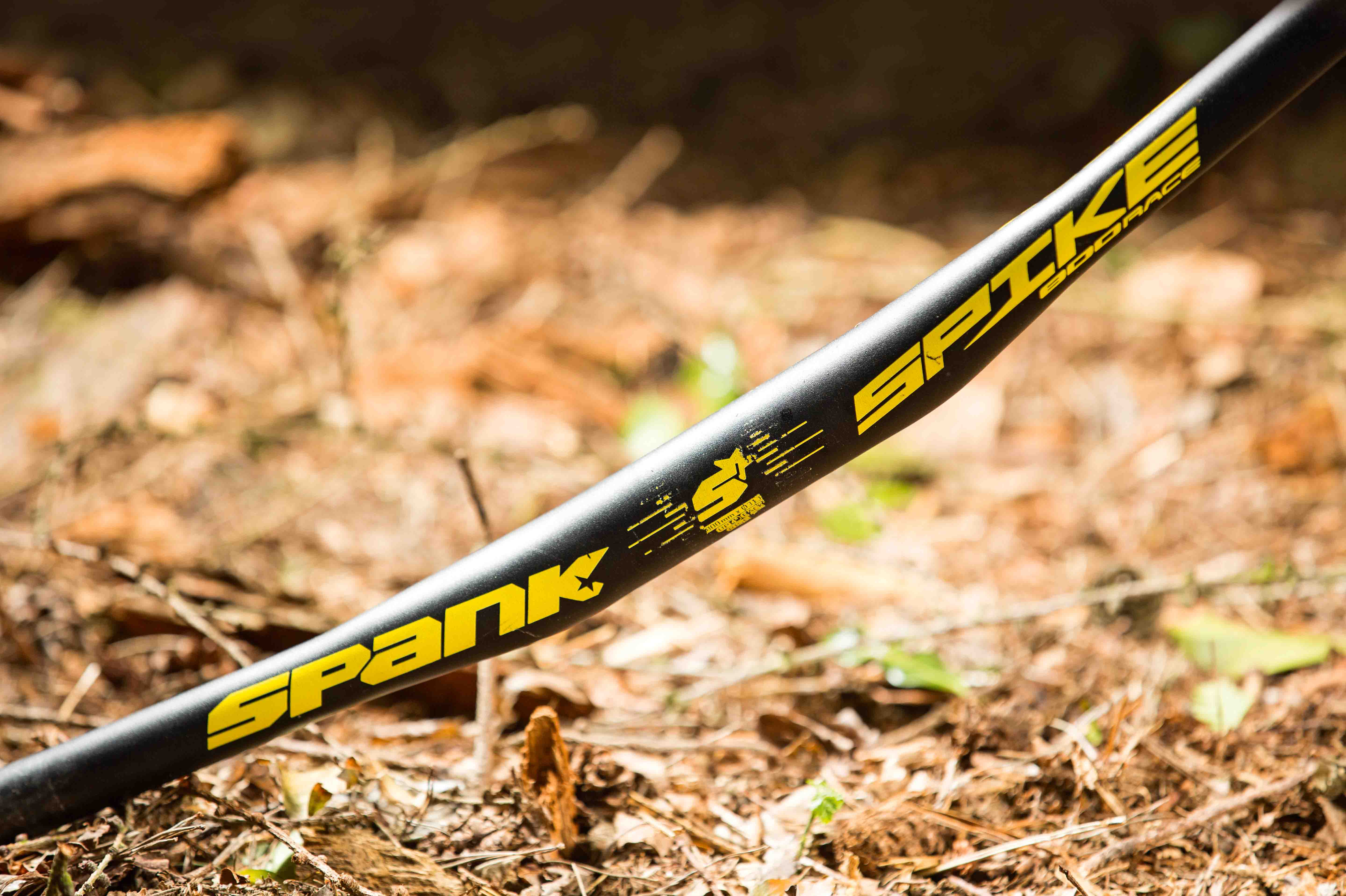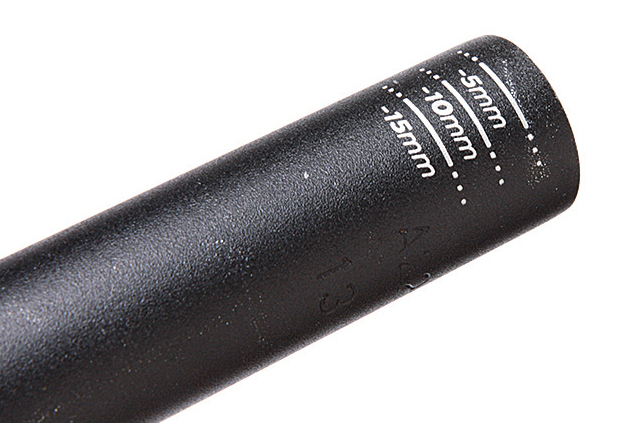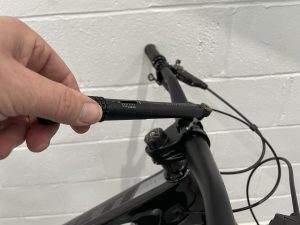The best handlebars will give you greater control and comfort while riding, and are a simple way to upgrade your bike. These are the best we've tested.
The best mountain bike handlebars are the right width and form to give you control and comfort when riding your bike, whether you’re climbing, descending, riding cross-country or enduro. We’ve tried and tested many to bring you our pick of the best, whatever your needs and budget. Don’t ignore the significance the best mountain bike grips can make to your ride as well, while the optimal mountain bike stem can make a big difference to comfort and handling.
Best MTB handlebars – quick list
- Best 35mm bar – OneUp Carbon
- Best budget 35mm bar – Race Face Atlas
- Best 31.8mm bar – Renthal Fatbar
- Best budget 31.8mm bar – DMR Wingbar
Best 35mm diameter bars

OneUp’s E Carbon handlebar noticeably reduces deflection from roots and rocks
1. OneUp Carbon E-Bar
Best for comfort and control
Weight: 249g | Width: 800mm | Rise: 35mm | Dimensions: 8° back, 5° up | Rating: 10/10
Reasons to buy:
- Improved comfort and control
- Reduced fatigue
Reasons to avoid:
- Not the lightest carbon bar
- Only available in 35mm rise in e-bike version
- Difficult to see markings
- Slight trade-off in steering accuracy
OneUp has designed its Carbon bar not to save weight, like most examples, but to improve comfort and control. With an ovalised bend, the bar is carefully tuned to offer more vertical compliance. And it works – during back-to-back testing we noticed the bike deflected less off big roots, which gave a calmer, more composed ride, and let us loosen our grip on the bars, which helped with fatigue.
It’s a 35mm diameter bar, with a 800mm width and integrated channels for hiding e-bike wiring. Gradients on the bar let you set up the rake of the bar to match your bike’s head angle, although they’re hard to read. Lots of bars claim to be compliant, but few can match the extra comfort dished out by the OneUp Carbon E-Bar and its analogue cousin, the Carbon Bar.
Read the full review of the OneUp Carbon E-Bar

OneUp’s Aluminium handlebar takes the sting out of the trail
2. OneUp Aluminium handlebar
Improved comfort at a lower price
Weight: 340g | Width: 800mm | Rise: 20mm or 30mm | Dimensions: 8° back, 5° up | Rating: 10/10
Reasons to buy:
- Two rise options
- Coloured decals supplied
- Tones down trail chatter and boosts comfort
Reasons to avoid:
- Matt anodised finish scuffed up quickly
- Only available in black
If you like the idea of the OneUp Carbon bar, but it’s a bit out of your price range, then the OneUp Aluminium handlebar will be right up your street. Available in two rises and a single 800mm width, it gets a shot-peened finish in stealth black, but there are stickers in the box to jazz it up.
Like the more expensive Carbon bar, it’s engineered to cut out some of the trail buzz that induces fatigue and can limit control. While it’s not as effective as the Carbon bar, it still does a remarkable job at reducing the volume of trail chatter. Jarring spikes are rounded off and it lets you charge into sections without getting spat into the weeds.
Read the full review of the OneUp Aluminium handlebar

The Race Face Next R handlebar has loads of space for lights and e-bike remotes
3. Race Face Next R handlebars
Best for crowded cockpits
Weight: 218g | Width: 800mm | Rise: 10, 20 or 35mm | Dimensions: 8° back, 5° up | Rating: 10/10
Reasons to buy:
- Good shape
- Lots of room for controls
- Good ride feel
Reasons to avoid:
- Costs more than an alloy bar
Race Face always features among our list of top handlebars, and the Next R gets particular praise for its comfortable ride quality and extended control zones, useful if you have lots of remotes and clamps crowding the bar.
Compared an aluminium Race Face bar, you can feel the extra flex. The steering is still direct, but the extra compliance helps keep you fresh on long descents. With a comfortable shape and loads of colour options, this is a great finishing touch to a boutique build.
Read the full review of the Race Face Next R handlebars

Race Face Six C handlebar is so wide we couldn’t fit it all in the shot
4. Race Face SixC handlebar
Best option if you want a wide bar
Weight: 239g | Width: 820mm | Rise: 20, 35mm | Dimensions: 8° back, 4° up | Rating: 9/10
Reasons to buy:
- Plenty of precision
- Great vertical compliance
- Full 820mm width
- Light
Reasons to avoid:
- Minimum cut length is 770mm
Wide bars feel great on big DH bikes and heavy e-bikes, when you’re riding 30mph moto jump lines and wide-open DH tracks. Obviously they’re not so good for tight, tree-lined singletrack. But if you only ride the former, then the expansive Race Face SixC could be just the ticket. At 820mm wide it’s a beast. Yes, you can cut it down, but only to 770mm. Which might be too wide for some.
Despite the width, it’s pretty light. And really comfortable. In fact it’s almost as compliant as the OneUp Aluminium bar. Even if cutting it down will reduce this.
Read our full review of the Race Face SixC handlebar

Hope’s Carbon Handlebar is a work of art
5. Hope Carbon Handlebars 35mm
Most attractive carbon handlebar
Weight: 224g | Width: 800mm | Rise: 20mm | Dimensions: 7° back, 5° up | Rating: 9/10
Reasons to buy:
- UK-made
- Beautiful exposed weave finish
- Muted ride sensation
Reasons to avoid:
- Lacks back sweep
- Only one rise option
Hope is a rare breed in this day and age in that it actually makes its bars in-house, here in the UK. And what a work of art it is, with a stunning exposed weave that matches its artisan carbon frames. It’s the same facility that builds the ultra-exotic GB Olympic track bikes.
While a full 800mm wide, the backsweep is less than average, so might not suit some riders. But we found that the wider bar with the 35mm clamp diameter is actually more comfortable than the 31.8mm version. Expensive, but exotic.
Read our full review of the Hope Carbon Handlebar 35mm

The Race Face Atlas is built tough
6. Race Face Atlas
Best ultra-wide alloy bar
Weight: 318g | Width: 820mm | Rise: 20 or 35mm | Dimensions: 8° back, 5° up | Rating: 9/10
Reasons to buy:
- Super strong with long life expectancy
- Wide enough for all tastes
Reasons to avoid:
- Super gloss finish requires careful brake/shifter/dropper clamping
- Lacks angle-dangle markings for controls
Ultra-strong, but wafer-thin, the Race Face Atlas bar is perfect for anyone that shuns carbon and prioritises durability. At 820mm, there’s no skimping on width, either, even if we can’t think of many riders who want to run a bar this broad.
Still, all that extra leverage comes in handy on a burly e-bike. Available in a load of colours, we were impressed by the durability of the finish. Even if we’d like to see some more gradients in the control zones for setting up your brake levers.
Read our full review of Race Face Atlas handlebar

PNW’s Loam Bar is even rated for DH use
7. PNW Loam Carbon
Best carbon bar for heavier riders
Weight: 241g (790mm) | Width: 800mm | Rise: 25mm or 38mm | Dimensions: 10° back, 5° up | Rating: 8/10
Reasons to buy:
- Comfortable shape
- Well-damped, to mute trail buzz
- Premium finish lasts well and resists scuffing
- Stiff and precise steering feel
- Rated for DH use
Reasons to avoid:
- Not as comfortable as OneUp’s carbon bar
- Expensive
- There are lighter carbon bars in this category
The PNW Loam Carbon handlebar is designed specifically to offer more comfort and vertical compliance than an alloy bar, to take the sting out of bumpy trails and introduce an extra level of comfort. The Loam bar is continuously tapered, rather than ovalized like some rivals targeting similar goals. It also has a 10° backsweep – a couple of degrees more than most – mated to a more standard 5° upsweep, together with a full 800mm width.
It proved strong and comfortable for our tester, on thousands of metres of Alpine descending, and he really liked the shape that feels natural on the wrists. However, forgiveness and flexibility on bigger hits is noticeably less than the OneUp 35mm carbon bar, so the Loam Carbon bar feels more like an effective vibration reduction tool than a big bump absorber.
Read our full review of the PNW Loam Carbon handlebar

Like Santa Cruz’s frames, its Carbon Riser gets a lifetime guarantee.
8. Santa Cruz Carbon Riser
Best bar for a lifetime warranty
Weight: 227g (800mm) | Width: 760mm or 800mm | Rise: 20mm | Dimensions: 9° up | Rating: 8/10
Reasons to buy:
- Two width options
- Subtle graphics
- Lifetime warranty
- Same carbon as Santa Cruz frames
- E-bike version available with internal routing
Reasons to avoid:
- Not the most forgiving carbon bar
- Only available in a 35mm bar clamp size
- Understated looks may not please everyone
- Limited rise options
The Santa Cruz Carbon riser bar is made from the same material technology as used on the brand’s frames and Reserve wheels. This is a classy, understated bar, with subtle logos, so it will blend in with any bike you fit it to. Weighing 227g, it’s lighter than most alloy bars but in the ballpark for contemporary carbon models. Santa Cruz has recently introduced an eCarbon model with internal routing, making it an alternative to the OneUp Carnon E-Bar.
The 9º back sweep and 20mm rise of the wider 800mm bar put our tester’s wrists in an optimum position and allowed him to fettle with bar height easily. The only other rise available is on a flat bar, with a 760mm width, and there’s no 31.8mm bar clamp option. For its width, this Santa Cruz bar sits at the stiffer end of the carbon spectrum and on longer rides our tester highlighted a need for more cushioned grips over his usual slimline choice.
Read our full review of the Santa Cruz Carbon Riser Bar
Best 31.8mm diameter handlebars

A little bit of moto-inspired coolness: The Renthal FatBar V2
1. Renthal FatBar V2
Best 31.8mm alloy handlebar
Weight: 364g | Width: 800mm | Rise: 10, 20, 30 or 40mm | Dimensions: 7° back, 5° up | Rating: 9/10
Reasons to buy:
- Modern classic that still cuts it
- Loads of rise options
Reasons to avoid:
- Not as wide as more modern offerings.
A modern classic handlebar. The blend of stiffness-to-flex is spot-on for all types of mountain biking. You don’t have to be railing World Cup downhills to get the benefits. And the iconic colour and logos make the perfect finishing touch to any custom build.
The Fatbar is not exactly light, but it’s beautifully made and really durable. You can also get it in a 35mm clamp version, and both diameters now come in a full 800mm width. Pair it with the Apex stem for a really solid and good-looking cockpit.
Read our full review of the Renthal FatBar handlebar

The Spank Spike 800 Vibrocore is not your regular hollow handlebar
2. Spank Spike 800 Vibrocore
Best for vibration reducing tech
Weight: 330g | Width: 800mm | Rise: 15, 30, 50mm | Dimensions: 8° back, 4° up | Rating: 10/10
Reasons to buy:
- Ideal for those looking for flatter grip angle
- Unique Vibrocore ‘filling’ genuinely reduces discomfort
Reasons to avoid:
- Graphics are a bit dated
- Shallow up-sweep can feel odd to some riders
In terms of stiffness, the Spike is solid and steers precisely, but there’s a distinctly deadened, dull sensation that’s similar, yet somehow different, to the feeling you get from the best-damped carbon bars. High frequency trail chatter was noticeably more muted, leaving our hands fresher and less sore at the bottom of tough descents.
How is this feeling achieved? Essentially by pumping the bar full of foam. No really. The essential idea here is that the foam can dissipate tiny vibration and chatter, leaving the metal handlebar being able to be made really stiff and inflexible. This Vibrocore foam buzz killing technology has since found its way into Spank’s other components (principally its wheel rims). And the Vibrocore filling only adds around 25g.
Read our full review of the Spank Spike 800 Vibrocore Race handlebar

Hope’s Carbon Handlebars are made right here in the UK
3. Hope Carbon Handlebar 31.8mm
Looks good and feels great
Weight: 225g | Width: 780mm | Rise: 20mm | Dimensions: 7° back, 5° up | Rating: 8/10
Reasons to buy:
- Rides even better than it looks
- UK made classy carbon
Reasons to avoid:
- Expensive
- One size only
No, you’re not seeing double. We did already list a Hope handlebar above in the shortlist of the best 35mm diameter handlebars. This bar here is the original 31.8mm version.
Carbon handlebars in the ‘old’ 31.8mm clamp size appear to be something of a dying breed, but this one is a good choice. For the money, a carbon bar isn’t the most costs effective way to save weight, but it’s a nice addition because it’s something you’re going to be looking at every time you ride. In that department, Hope’s Carbon riser is tough to beat. It looks stunning, but the high price (and lack of rise options) does count against it.
Read our full review of the Hope Carbon handlebars

Great value and with a lofty 50mm rise option – the DMR Wingbar Mk4.
4. DMR Wingbar MK4
Best value aluminium bar
Weight: 322g (800mm) | Width: 780 or 800mm | Rise: 20mm, 35mm | Dimensions: 8° back, 5° up | Rating: 10/10
Reasons to buy:
- Reassuringly stiff and strong
- Affordable price
- Useful rise, width and clamp size options
- Olly Wilkins (ODUB) model available in a 50mm rise
Reasons to avoid:
- Heavy
- No carbon option
- Camo colour options bump up the price
As with most of this UK-based brand’s products, the DMR Wingbar is aimed at pretty much everything from trail riding to full-on DH use. Now featuring a fresh gloss black finish complete with bright white logos, it should match more bikes than ever before. And with width, rise and bar clamp size options the Wingbar MK4 should fit more riders and bike set-ups too.
The Wingbar’s measurements add up to a properly comfortable cockpit setup – our tester found the 5° upsweep keeps the bar feeling nice and straight, whilst 8° of backsweep places your wrists in a comfortable, neutral position both in and out of the saddle. The robust 7075 aluminium construction might not make the Wingbar the lightest of its type but what it does do is provide stiffness and strength in spades. We tested it on everything from fast, chattery rooty strewn trails through to savage Alpine rock gardens and it showed no noticeable or unwanted flex felt when pushing on hard.
Read our full review of the DMR Wingbar Mk4

The 800mm-wide Burgtec bar has perfect profile
Other mountain bike handlebars to consider: 35mm bars
When we reviewed the Burgtec Ride Wide Carbon Enduro handlebar in 2017 it was bang up-to-date in terms of width and stiffness. At 800mm it’s a full-width bar, with a pleasingly familiar backsweep and upsweep and two rise options. Although we’ve not ridden it back-to-back with the latest carbon bars from OneUp, Race Face or PNW, Burgtec had this bar dialled from the start, so it’s still a relevant upgrade for a harder-hitting trail or enduro bike.
Spank Industries offers loads of mountain bike handlebars including its test-winning Vibrocore model with vibration-damping foam cores. The Spank Spoon 35 is the brand’s more affordable alloy handlebar – it uses the same proprietary 6-series aluminium blend, but omits the closed-cell foam inside to keep the price lower. Our tester, Mick Kirkman, has always got on well with Spank bars and this Spoon model is no exception. The shape is really natural, with no pressure points in the heel of the palm and there’s loads of room inboard of the grips for spacing lever clamps.

E*Thirteen Race Carbon bars paired with the great value E*Thirteen Base stem.
E*Thirteen has expanded its product range to offer a variety of handlebars, including this top-tier model, the E*Thirteen Race Carbon. Bar geometry is slightly more swept than rivals like Race Face and Renthal, with a 9° backsweep and 5° upsweep. Out on the trails, our tester noted that the Race Carbon bar delivers an excellent ride feel by being solid and positive, but with calmly controlled vibration and chatter.
We tested two carbon handlebars from Deity in 2023, both with the (now commonplace) 35mm clamp diameter. The Deity Skywire is a full-width 800mm bar and lightweight too – our sample weighed 223g. We found the ride quality to be a touch less forgiving than our test-winning carbon bars, but if you want to add some precision and save weight, the Deity Skywire bar is a good choice for enduro racing and harder riding.

Deity’s Skywire carbon handlebar has typically bold graphics.
Designed for DH and enduro, the Deity Speedway is the brand’s burliest 35mm carbon bar. It comes in a massive 810mm width, laid up with unidirectional carbon using in-house only moulds. Deity has nailed the vibration damping with a dull feel that’s never twangy, but overall stiffness and lack of a little give means it can get a bit uncomfortable. Our Review suggested that unless you’re a heavy 100kg rider, or just love a very stiff set up, Deity’s 35mm Skywire bar will probably strike a better balance.
The Truvativ Descendant DH 35 bar is part of a range of bigger bore models in both carbon and alloy, with plenty of pro rider signature geometries and widths. This aluminium bar measures 800mm in width, weighs 315g and uses proven sweep numbers of 5° up and 9° back. Our tester highlighted the super-precise steering, but also mentioned that although the Descendant bar is far from the most brutal 35mm option around, he prefers a more damped feel.
Although certified as strong enough for DH riding, the first thing that strikes you is how amazingly light the 800mm wide USE Ultimate Boom Carbon bar feels. It weighs only 218g. Our tester was impressed with the ride quality too, commenting that the Boom bar somehow manages to bring a slightly springy, comforting feel to the hands without feeling overly soft and flexy.

Wide and bright. The Kingpin measures in at 785mm.
Other mountain bike handlebars to consider: 31.8mm bars
From Shimano’s component division comes the Pro Tharsis 9.8, a solid and dependable 800mm wide, DH-rated, aluminium handlebar. It’s ultra-stiff and hasn’t missed a beat over hundreds of kms and fitted to numerous test bikes. It’s now been renamed, as the Tharsis 3Five, with a move from a 31.8mm to 35mm bar clamp size.
Plenty of width, rise and colour options along with a bang-on stiffness/flex ratio make the aluminium Funn Kingpin handlebar another good choice for your long travel bike. Weighing in at 282 grams – in the narrower 785mm x 31,8mm width/diameter we tested – it’s a few grams heavier than the best bars but lighter than many aluminium models. The Kingpin is also a touch cheaper than a lot of the rivals, so that weight discrepancy can easily be overlooked.
What do I look for in the best mountain bike handlebars?
We’ve come a long way from the shoulder-width steerers of the nineties and modern geometry theorists will tell you that wide bars are the way to go. It’s always a question of personal preference though, and other factors include things like where you ride. Tight and twisty trails with loads of trees close together? You may prefer to go a little narrower…though still wider than the old days of mountain biking!

The perfect bar width varies depending on your build and the terrain you’re riding. Most people end up somewhere between 760mm and 800mm.
Width
We think you should be aiming for at least 760mm. While this may seem extreme, in the majority of cases they will add a level of control and stability that can transform the way your bike rides. Plus, a wider bar doesn’t cost any extra and you can always cut it down.
Rise
The shape of a bar is dictated by three key measurements: rise, backsweep and upsweep. Rise is typical measured in millimetres — hence 20 or 30mm rise — and basically indicates the bar’s height.
If you’re tall and/or you’ve not changed your bar rise for several years but have moved on to longer and longer reach bikes, we’d strongly recommend going for a higher rise bar than you’ve used previously i.e. 35mm rise or higher.

Clamp diameters come in 31.8mm or 35mm
Clamp diameter
The majority of handlebars are 35mm or 31.8mm stem clamp diameter ie. they fit in a 31.8mm stem. You will need to also have/buy a stem to go with them so don’t forget to budget for that too when buying new bars, unless you already have one the right size.

Material choices
Carbon or aluminium
Aluminium or carbon is the choice. Aluminium is cheaper. Carbon is lighter. Carbon bars can be stiffer – some can even be uncomfortably stiff.
Obviously there is a spread of prices and materials here, which means there is something for every pocket. Carbon bars are pricy, but they are superbly made and you’re looking at roughly a 150 gram weight saving over the aluminium alternatives
What you’re looking for is a perfect balance between stiffness, comfort and resilience. If you can also get a bar that’s light and wide enough, then you’re probably looking at a winner.

The red lines indicate the upsweep (height) of the handlebars and the green lines the backsweep (depth) of them
Sweep angles
Backsweep and upsweep are measured in degrees and they affect the angle of the bit you hold.
Not all manufacturers produce bars in multiple rises, and you need to consider stem angle and bar rise together to achieve your perfect bar height. All of our favourite bars combine upsweep and backsweep, so we’d avoid any that are too flat or angled too far back.

Trim to width
Cut marks and reference marks
You should know how to get your controls at the same angle by eye, but to reduce the guesswork several manufacturers print reference marks on the bar.
Cut marks are a handy addition if you want to trim the bar and don’t own a tape measure. They also allow you to ignore the old maxim ‘measure twice, cut once.’
















